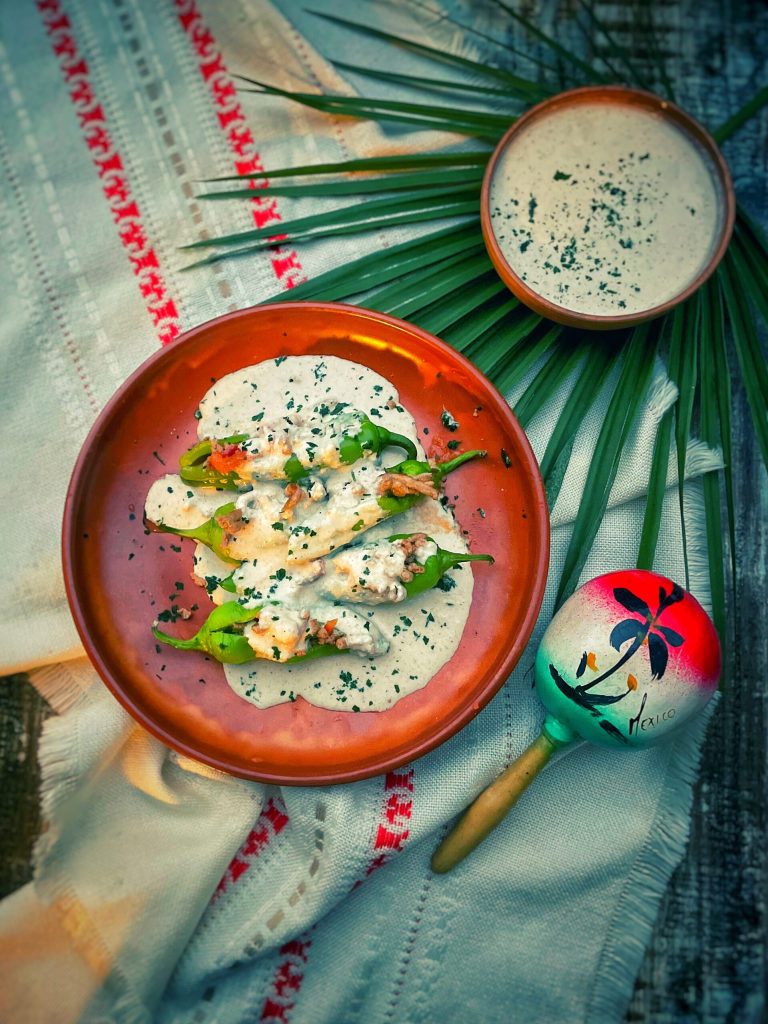The chiles en nogada is one of the most emblematic dishes of Mexican cuisine, originating from the state of Puebla, poblano peppers stuffed with picadillo and served with nogada sauce.
The nogada sauce is a creamy sauce made from walnuts, milk, cream, and fresh cheese; it derives from the word “nuez” (nut in Spanish), and “nogada” indicates a walnut sauce that traditionally comes from the nogal de Castilla (Castilian walnut) variety.
It is part of the novohispanic baroque cuisine, born among convents and aristocratic families of Puebla in the 18th–19th centuries.
According to tradition, chiles en nogada were created in 1821 by the Augustinian nuns of the Santa Mónica convent in Puebla to celebrate Mexico’s independence and honor Agustín de Iturbide.
The colors of the dish—green (chile), white (nogada), and red (pomegranate)—represent the Mexican flag.
This dish is prepared in central Mexico in August and the first half of September when pomegranates are in season.
On the blog, you can also find the recipe for:

- Difficulty: Medium
- Cost: Economical
- Preparation time: 15 Minutes
- Portions: 6 Pieces
- Cooking methods: Stovetop, Oven
- Cuisine: Mexican
- Seasonality: Summer, All seasons
Ingredients
- 6 poblano peppers (large, sweet, non-spicy green peppers)
- to taste pomegranate seeds
- to taste parsley
- 10.5 oz ground beef (or pork or a combination)
- 1 panochera apple
- 1 pear
- 1 criolla peach
- 1 ripe plantain
- 1.8 oz raisins
- 1.8 oz almonds
- 1.8 oz pine nuts
- 1 tomato
- 1 onion
- 1 clove garlic
- 1 tbsp acitron (or candied fruit)
- to taste cinnamon
- to taste cumin
- to taste oregano
- to taste salt and pepper
- 7 oz Castilla walnuts
- 0.42 cups milk
- 0.42 cups cream
- 3.5 oz fresh cheese
- 1 small glass sherry (optional)
Steps
Preparation of chiles:
Roast the chiles over an open flame or in the oven until the skin blackens.
Place them in a plastic bag for 15 minutes to ease skin removal.
Gently peel off the skin, make a longitudinal cut and remove seeds and veins.
Preparation of picadillo:
In a pan, sauté chopped onion and garlic until golden.
Add the ground meat and cook until fully done.
Incorporate chopped tomato and cook for 5 minutes.
Add chopped fruits, raisins, almonds, pine nuts, and acitrón.
Season with cinnamon, salt, and pepper. Cook over medium heat for 10-15 minutes, stirring occasionally.
Preparation of nogada:
Blend peeled walnuts with milk, cheese, sugar, cinnamon, and sherry until a smooth, creamy sauce is obtained. If necessary, add more milk to adjust consistency.
Stuff each chile with the prepared picadillo.
Arrange the chiles on a serving platter with the sauce on top and garnish with pomegranate seeds and parsley.
Regional Variations:
Capeado (battered): Some versions involve dipping the chiles in an egg batter and frying them before topping with the nogada.
Without meat: There are vegetarian versions prevalent in Mexican families, especially during Advent or to offer lighter versions of the dish.
Instead of meat, a mix of fresh fruit, dried fruit, spices, and sometimes vegetables is used, maintaining the sweet and sour flavors typical of the original filling (picadillo).
Instead of meat, a mix of fresh fruit, dried fruit, spices, and sometimes vegetables is used, maintaining the sweet and sour flavors typical of the original filling (picadillo).
FAQ (Questions and Answers)
What is picadillo?
Picadillo is a traditional dish of Spanish origin, widespread in many Latin American countries and the Philippines, made with ground meat, usually beef, cooked with tomatoes, onions, spices, and sometimes other ingredients (such as fruit).
The term derives from the Spanish “picar,” which means to mince, referring to the minced meat.What are some recipes, not just Mexican, with picadillo?
Here are some typical recipes that use it as a filling or main dish:
🇲🇽 Mexico
Chiles en nogada.
Chiles rellenos: peppers stuffed with picadillo, breaded and fried.
Tamales and gorditas.
The chili con carne may resemble a “spicy stew picadillo,” but it is a dish on its own, with Texan roots and a much spicier and robust profile.
🇨🇺 Cuba
Picadillo a la habanera: meat with onion, peppers, olives, raisins, tomato; served with white rice or tostones.
Cuban empanadas: pastries filled with picadillo.
🇵🇷 Puerto Rico
Alcapurrias: plantain fritters filled with picadillo.
Pastelón: a type of lasagna with layers of fried ripe plantain and picadillo.
Empanadillas: fried turnovers with meat filling.
🇵🇦 Panama / Costa Rica / Nicaragua
Used in:
Tamal de olla (corn and meat pie)
Stuffed tortillas
Arroz con picadillo
🇵🇭 Philippines
Filipino picadillo (giniling): ground meat with potatoes, carrots, soy sauce, and sometimes raisins or peas. Served with rice.
🇪🇸 Spain
Picadillo gallego: ground meat sautéed with paprika, potatoes, sometimes used as a filling for empanadas or peppers.Are chiles rellenos and chiles en nogada the same recipe?
No, Chile Relleno and Chile en Nogada are not the same recipe, although they share some elements.
Here are the differences:
🌶️ Chile Relleno
Origin: widespread throughout Mexico
Peppers used: poblano
Filling: usually cheese, but also meat or vegetables
Technique: pepper is roasted, peeled, stuffed, then breaded and fried
Sauce: often a red or tomato sauce
🇲🇽 Chile en Nogada
Origin: Puebla, tied to Mexico’s independence
Peppers used: poblano
Filling: sweet-savory picadillo (ground meat, dried fruit, fresh fruit, spices)
Technique: roasted, peeled pepper, stuffed but not fried
Sauce: cold walnut sauce (nogada) with cream and fresh cheese
Decoration: pomegranate seeds and parsley (colors of the flag)
Summary:
Chile Relleno = fried, simple filling, hot sauce
Chile en Nogada = not fried, sweet-savory filling, cold walnut sauce

